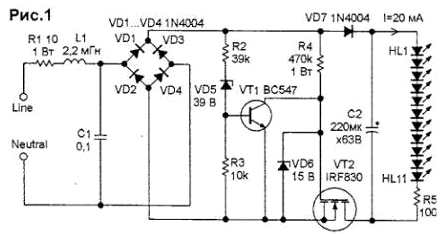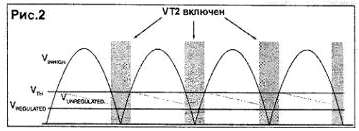When you use led lights for decorating Windows, lighting, signage and so it is convenient to feed directly from the mains through a rectifier and ballast resistor, to not install extra low voltage power supply. But in the pauses between the rectified half-cycles of the mains voltage the power supply to the LEDs is missing, what leads to unpleasant flickering.
The proposed device (Fig.1) anti-flicker, operates from AC voltage 120...230 V and allows you to adjust the output voltage.

The operation of the circuit based on the operation time of opening key transistor VT2. When the rectified voltage is lower than set by the Zener diode VD5 threshold The Uпор, Zener closed, respectively, is closed and the transistor VT1. Rectified the voltage across R4 is served on the shutter VT2, and it is included. Zener diode VD6 limits the voltage across the gate of VT2. Through outdoor VT2 is charging the storage capacitor C2 and is fed by a chain of LEDs HL1...HL11.
When straightened the voltage exceeds the Uпор, breaks Zener diode VD5 and opens the transistor VT1, which bypasses the valve VT2, and the latter is closed. The LEDs are powered from the charged capacitor C2, the voltage at it gradually decreases (Fig.2). Diode VD7 prevents discharge of C2 through the control circuit.

The recession of the output voltage is determined by the load current and the capacitance C2. For normal illumination of the LEDs, the voltage on C2 should not to drop below the ignition threshold garlands. The key VT2 is only revealed at low voltage, thereby the dissipated power on it is small. The resistor - fuse protect the circuit R1 and limits inrush current when you turn on AC voltage. Filter L1-C1 eliminates high-frequency noise arising from the operation of the circuit.
Author: TA Babu, India; Publication: www.rlocman.ru






